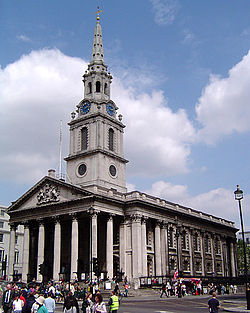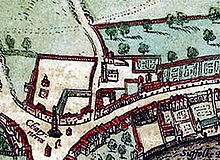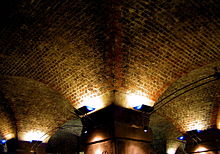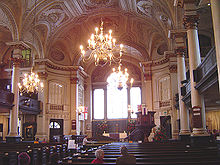- St Martin-in-the-Fields
-
For the civil parish abolished in 1922, see St Martin in the Fields (parish). For the chamber orchestra, see Academy of St Martin in the Fields.
St Martin-in-the-Fields 
St Martin-in-the-Fields, LondonCountry United Kingdom Denomination Church of England Architecture Architect(s) James Gibbs St Martin-in-the-Fields is an Anglican church at the north-east corner of Trafalgar Square in the City of Westminster, London. Its patron is Saint Martin of Tours.
Contents
History
Roman era
 St Martin-in-the-Fields and Charing Cross, circa 1562
St Martin-in-the-Fields and Charing Cross, circa 1562
Excavations at the site in 2006 led to the discovery of a grave dated about 410.[1] The site is outside the city limits of Roman London (as was the usual Roman practice for burials) but is particularly interesting for being so far outside, and this is leading to a reappraisal of Westminster's importance at that time. The burial is thought by some to mark a Christian centre of that time (possibly reusing the site or building of a pagan temple).
Medieval and Tudor
The earliest extant reference to the church is from 1222, with a dispute between the Abbot of Westminster and the Bishop of London as to who had control over it. It was decided in favour of Westminster, and used by the monks of Westminster Abbey.[citation needed]
The church was rebuilt by Henry VIII in 1542 to avoid plague victims from the area having to pass through his Palace of Whitehall. At this time, it was literally "in the fields" in an isolated position between the cities of Westminster and London.
A number of notables were buried in this phase of the church, including Robert Boyle and Nell Gwynne.
Present church
By the reign of James I the church was becoming inadequate for the congregation, due to the great increase in population in the area. In 1606 the king granted an acre of ground on the west side of St. Martin's Lane for a new churchyard, and the church was enlarged. Later in the seventeenth century, galleries were added, and the creation of the new parishes of St Anne, Soho, and St James, Piccadilly, and the opening of a chapel in Oxenden Street relieved some of the pressure on space. [2]
A survey of 1710 found that the walls and roof were in a state of decay. In 1 720, an act was passed for the rebuilding of the church allowing for a sum of up to £22,000, to be raised by a rate on the parishioners. A temporary church was erected partly on the churchyard and partly on ground in Lancaster Court. Advertisements were placed in the newspapers that bodies and monuments of those buried in the church or churchyard could be taken away for reinterment by relatives. [2]
The rebuilding commissioners selected James Gibbs to design the new church. His first suggestion was for a church with a circular nave and a domed ceiling; .[3] this was considered too expensive, and Gibbs then produced a simpler rectilinear plan, which was accepted. The foundation stone was laid on 19 March, 1722, and the last stone of the spire was placed in position in December 1724. The total cost was £33,661 including the architect's fees. [2]
The west front of the St Martin’s has a portico with a pediment supported by a giant order of Corinthian columns, six wide. The order is continued around the church by pilasters. In designing the church, Gibbs was influenced by the works of Christopher Wren, but departed from Wren’s practice in his integration of the tower into the church. Rather than considering it as an adjunct to the main body of the building, he constructed it within its west wall, so that it rises above the roof, immediately behind the portico, [3] an arrangement previously used by John James at St George, Hanover Square (1712-24)<, though James’ steeple was much less ambitious. (1712-24)[4]. The spire of of St Martin’s rises 192 feet above the level of the church floor. [2]
The church is rectangular in plan, with the five-bay nave divided from the aisles by arcades of Corinthian columns. There are galleries over both aisles and at the west end. The nave ceiling is a flattened barrel vault, divided into panels by ribs. The panels are decorated with cherubs, clouds, shells, and scroll work, by Giuseppe Artari and Bagutti. [2]
The design was criticised widely at the time, but subsequently became extremely famous, being copied particularly widely in the United States.[5] St Andrews Church, Egmore, Chennai is a copy of this church.
Various 18th-century notables were soon buried in the new church, including the émigré sculptor Roubiliac (who had settled in this area of London) and the furniture-maker Thomas Chippendale (whose workshop was in the same street as the church, St Martin's Lane[6]), along with Jack Sheppard in the now lost adjoining churchyard.
The church also had its own almhouses and pension-charity, which was established on 21 Sep 1886. Its 19 trustees administered almshouses for women, providing them with a weekly stipend. The almshouses were built in 1818 on part of the parish burial ground in Camden Town and St Pancras and replaced ones built in 1683.[7]
The church has a close relationship with the Royal Family, whose parish church it is,[8] as well as with 10 Downing Street and the Admiralty.[9]
Recent times
 The ceiling of the café in the crypt
The ceiling of the café in the crypt
Because of its prominent position, St Martin-in-the-Fields is one of the most famous non-cathedral churches in London. Its ethos as the "Church of the Ever Open Door" (a title coined by Dick Sheppard, Vicar in the early 20th century when the work with homeless people was started) continues today, even though it is not possible for it literally to be the case. It is famous for its work with homeless people through The Connection at St Martin's[10] which shares with The Vicar's Relief Fund the money raised each year by the BBC Radio 4 Appeal's Christmas appeal.[11] The church is also known for its regular lunchtime and evening concerts: many ensembles perform there, including the Academy of St Martin-in-the-Fields, which was co-founded by Sir Neville Marriner and John Churchill, a former Master of Music at St Martin's. There is a popular café in the crypt, where jazz concerts are held. All profits from this go to the work of the church. The crypt is also home to the London Brass Rubbing Centre, an art gallery and a book and gift shop.
In January 2006 work began on a £36-million renewal project. The project included renewing the church itself, as well as provision of facilities encompassing the church's crypt, a row of buildings to the north and some significant new underground spaces in between. The funding included a grant of £15.35 million from the Heritage Lottery Fund. The church and crypt reopened in the summer of 2008. As part of the public fundraising, it is possible to sponsor a pane of glass and 'give light to St Martin's'.[12]
Twelve historic bells from St Martin-in-the-Fields are included in the peal of the Swan Bells tower in Perth, Western Australia.
List of organists
Organists include:
- John Weldon 1714–1736
- Joseph Kelway 1736–1781 (formerly organist of St Michael, Cornhill)
- Benjamin Cooke 1781–1793
- Robert Cooke 1793–1814 (son of Benjamin Cooke)
- Thomas Forbes Gerrard Walmisley 1814–1854?
- William Thomas Best 1852–1855?
- Martin Shaw 1920–1924
- Arnold Goldsborough 1924–1935
- John Alden 1935-1938
- Stanley Drummond Wolff 1938–1946
- John Churchill 1949 – 1967
- Christopher Stokes
- Paul Stubbings
- Nick Danks 2001–2008
- Andrew Earis 2009 –
St Martin's school
In 1699 the church (which was controlled by the Society for Promoting Christian Knowledge) founded a school for poor and less fortunate boys, which later became a girls' school. The school was originally in Charing Cross Road, near the church. It was known as St Martin’s Middle Class School for Girls, latterly known as St Martin-in-the-Fields High School for Girls. The school flourished in what was a populous, fast-growing parish. It was relocated to its present Lambeth site in 1928.
The school badge depicts the eponymous St Martin of Tours. The school's Latin motto Caritate et disciplina translates as "With love and learning".[5] The school is Christian but accepts girls of all faiths.
See also
- List of churches and cathedrals of London
- Academy of St Martin in the Fields
Notes and references
- ^ BBC News
- ^ a b c d e G. H. Gater and F. R. Hiorns (editor) (1940). martin in the fields "The church of St. Martin-in-the-Fields: Description". Survey of London: volume 20: St Martin-in-the-Fields, pt III: Trafalgar Square & Neighbourhood. Institute of Historical Research. http://www.british-history.ac.uk/report.aspx?compid=68409&strquery=st martin in the fields. Retrieved 19 November 2011.
- ^ a b Summerson, John (1970). Architecture in Britain, 1530 to 1830. Pelican History of Art. Harmondsworth: Penguin Books. pp. 350-3.
- ^ >Summerson, John (1970). Architecture in Britain, 1530 to 1830. Pelican History of Art. Harmondsworth: Penguin Books. p. 309.
- ^ a b Sheppard, F.H.W. (1998). London : a history. Oxford: Oxford University Press. ISBN 0-19-822922-4.
- ^ When built the church was on St Martin's Lane; and it was only much later, with the building of Trafalgar Square, that its spectacular architecture attained the eminence that it has today.
- ^ http://londonfamilyhistory.blogspot.com/2009/05/st-martin-in-fields.html
- ^ King George I was a churchwarden and Queen Mary attended regularly.
- ^ This falls within its parish, and the Trafalgar Square link strengthens the bond — the church flies the White Ensign of the Royal Navy rather than the Union Flag, and traditionally the church's bells are rung to proclaim a naval victory.
- ^ Connection at St Martins website
- ^ "The St Martin-in-the-Fields BBC Radio 4 Christmas Appeal". St Martin-in-the-Fields. http://www2.stmartin-in-the-fields.org/page/care/appeal.html. Retrieved 2009-04-23.
- ^ Give Light to St Martin's website
External links
- St Martin-in-the-Fields website
- Connection at St Martin's website
- Give Light to St Martin's Campaign Appeal
- Roman occupation of church site
- Mystery Worshipper Report at the Ship of Fools website
- Deanery of Westminster (St Margaret)
Coordinates: 51°30′32″N 0°07′37″W / 51.50889°N 0.12694°W
Trafalgar Square, London Buildings Clockwise from North: National Gallery (architect: William Wilkins) · St Martin-in-the-Fields (James Gibbs) · South Africa House (Herbert Baker) · Drummonds Bank (Philip Hardwick) · Admiralty Arch (Aston Webb) · Uganda House · Canadian Pacific building · Canada House (Robert Smirke) ·

Memorials Nelson's Column (William Railton, Edward Hodges Baily) · Charing Cross · See all
Architects Charles Barry · Norman Foster · Edwin Lutyens · John Nash
Fourth plinth sculptors Former buildings Events Adjacent streets Categories:- Religious buildings completed in 1726
- Trafalgar Square
- Churches in Westminster
- Church of England churches in London
- James Gibbs buildings
- Grade I listed churches in London
Wikimedia Foundation. 2010.

